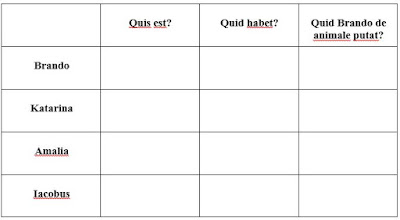I have always enjoyed teaching Roman culture to students, because it is such a rich topic. In the past, I have had students who have absolutely hated reading Latin but when it came to culture, they enjoyed every moment of the discussion. Many Latin textbooks try to tie in their readings to a particular cultural topic, such as the baths, gladiatorial games, life in different parts of the Roman empire, etc. The problem though has been that so many times, the actual teaching of culture is relegated to an English section. While this does provide lots of useful information, as a language teacher, I want my students to learn about culture in the language itself, so that culture is not viewed as outside of the language but rather as part of the language. The other side of it though is that one can go overboard with too much vocabulary in a creating a culture-based reading in Latin so that it ends up becoming too incomprehensible and overwhelming for students to read.
At my former school, when I made the decision to do a hybrid textbook/CI approach, I loved the freedom to be able to teach the textbook in whatever way I wanted and in whatever order I wanted. The problem, though, was that I still had to cover the culture sections from the textbook, as that was on my instructional team's final exam. To teach the depth of the cultural material in a level-appropriate target language manner did not seem possible, so I would always have to take a full-day to cover the culture material in English through a lecture so that I could get it out of the way.
At my new school, however, where I am one of five CI Latin teachers and where we all have completely "untextbooked," culture is introduced and taught through a level-appropriate reading. In other words, like any other reading passage, the cultural reading involves pre-reading, reading, and post-reading. Bob Patrick and I teach all of the Latin 1 sections (we have nine!), so last week, we decided that we wanted to introduce the Roman domus vs. insulae. As a result, Bob wrote up a reading passage in a level-appropriate, Latin 1 language which explained life in the Roman insula vs. domus, which also included an adapted version of Horace's "City Mouse and Country Mouse" story. While Bob wrote the passage, I was in charge of creating the lesson plans. For some reason, when given this task, I found myself struggling to do this, because it meant introducing lots of topic-specific words about the house - how could I introduce these words in a compelling way?
The following is my lesson plan for how Bob and I "taught" the Roman insula for Latin 1 (we just finished this yesterday!). The goal is to use the Horace story as a transition for another reading about the Roman house (this will be a later blog posting):
UBI ROMANI HABITAVERUNT
In Romā antiquā (ancient), multī hōminēs (people) in insulīs (apartment buildings) habitaverunt. Frequenter, familia in unō conclavi (room) habitavit. Aqua non in insulīs erat (there was). Latrina non in insulīs erat. Aqua publica erat. Latrina publica erat. Culina non in insulīs erat. Cubiculum non in insulīs erat. unum conclave (room) erat (there was), et tota (entire) familia in conclavi (room) habitavit. difficile erat (it was) in insulīs habitāre.
Day 1
- Target vocabulary - culina, cubiculum, tablinum, latrina, coquit, dormit, scribit, dentes fricat. Preview target vocabulary by writing them on the board with their English meanings. Go over each word and their meaning. Ask English derivatives as a way for students to connect words with known vocabulary.
- Rooms of the house PowerPoint with circling and PQAs - if you are familiar with stage 1 of CLC, you will recognize these types of sentences! Some great PQAs for this are "cui Kanye coquit? cur?", "cui Praeses Obama scribit? Donald Trumpo? Justin Biebero?", "mavis dormire in cubiculo an in culina?" "mavis dentes fricare in latrina an in culina? in cubiculo?"
- Movie Talk - iPad vs. Paper
Day 2
- Review rooms of the house ppt
- Target vocabulary for Movie Talk - vir, cubiculum, latrina, intrat, abit, horologium, per scalas descendit, culina, domum, iterum. Preview target vocabulary by writing them on the board with their English meanings. Go over each word and their meaning. Ask English derivatives as a way for students to connect words with known vocabulary.
- Movie Talk - Destiny
Day 3
- mavis habitare ppt - this activity actually took MUCH longer than I thought it would, as students really wanted to discuss this!
- Hand out reading for students to read silently
- Review reading in order to establish meaning.
- Discuss culture in English to "fill in the gaps."
Day 4
- Review reading if needed
- Verum/Falsum de Insulis ppt - students wanted to use whiteboards to show me their answers
- Products, Practices, and Perspectives handout - this helps students better understand the three P's but still use the passage. I was surprised at how QUICKLY students were able to complete this after only having gone through the reading the day before!
Observations
- Although I felt like I struggled to create a lesson plan which surrounded a culture-based reading, I was pleased with the results.
- Though the idea of a CI-based reading to introduce culture did not feel natural to me, students did not seem to think that it was any different from what we had been doing before.
- I love this approach! It is still going to take me time to learn how to do it better, but I am definitely on board with doing it this way!
I will blog in the future about how the rest of the culture-based reading on the Roman house and the adapted Horace story goes, as that is currently a work in progress - not ready for public viewing yet.




